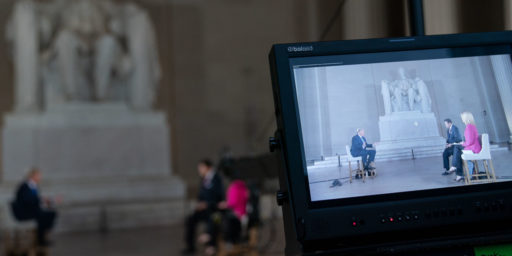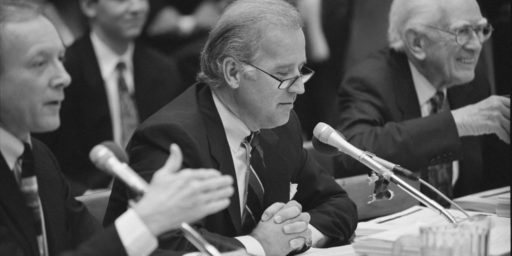Some Comments on the Gosnell Story
A mix of media and abortion politics.
Over the last week or so, the story of Kermit Gosnell’s trial has been percolating up to the surface after a USAT editorial by Kirsten Powers raised the question of why the story has not received more media attention.
Let me stipulate that this is a terrible, stomach-churning one, regardless of one’s politics. It is truly horrific, and the kind of thing that one wants to think is impossible in general, and certainly not possible in the United States of America. Conor Friedsdorf has the details, if one is still unfamiliar.
At the moment I have no comments on the trial itself, save that clearly if the charges are true, the man and his accomplices deserve severe punishment, but I would like to think that such proclamations could go with saying. Rather, I am interested in the politics of it all, both in terms of the media issue, as well as what the charges mean to both the pro-life and pro-choice positions.
Some observations on the media angle:
My initial response upon reading about the trial for the first time about a week ago (as a result of a friend’s FB post) was that I was surprised it was not being more widely covered. The reason I had this reaction was not because I suspected some mass media bias in the case. I was surprised because cable new in particular seems to thrive on this type of crime story. After all, it is a gruesome tale in the context of an ongoing trial. As such, it is nearly free programming for the cable channels. I did not have time to blog on the topic (or, really, much of anything) at the time, but have thought about the story and read a bit more about it after that point in time. In so doing, it did occur to me that the truly gruesome nature of crime probably did dissuade some form reporting on it (see, for example, Megan McArdle on this topic)—after all, and we forget this, the news industry’s main job is not providing information, it is selling commercials by entertaining us (we forget this fact far too often). Further, while cable news viewers might be willing to ingest hours and hours about a trial that focused on a kidnapping/murder, would they sit down to lunch and listen to the details of the Gosnell trial over and over? (Back to the infotainment point: while the public consumes a lot of crime shows and movies, when the storylines get too gruesome, the audience shrinks).
Still, it is hard to see how such a dramatic story did not make its way to the cable news rotation, let alone have more coverage nationally via various media outlets. Of course, the fact that the story has now broken and being are now being covered in various locations does underscore that the story was not be actively suppressed (and, by extension, shows how hard it would be to truly suppress a story if that was the goal).
It is worth pointing out that national media had not totally ignored the story, either: CBS and NPR both noted the story back in 2011, and, for that matter, it was covered by that bastion of conservatism,* The Nation: Dr. Kermit Gosnell’s Horror Show (h/t: Irin Carmon who has other links as well).
Further, in regards to the notion that the story has been ignored because the mainstream media is pro-choice, and therefore feared to tell the tale, I would note that the story wasn’t exactly part of the daily fare on Fox New Channel, either (nor was it especially prominent in the conservative press in general—see, for example, Alex-Seitz-Wald). As such, it is difficult to make the case that this story was ignored due to liberal bias.
One aspect of this story that I think some on the pro-life side are missing: Gosnell represents the nightmare of both the pro-life and the pro-choice sides. For anti-abortion advocates, Gosnell just represents what they think of the entire enterprise: the slaughter of babies. From the pro-abortion side, Gosnell represents what they argue would happen across the country if abortion were illegal: backroom hacks engaging in horrific practices and specifically preying on desperate poor women.
In short: I agree that it is odd, given our sensationalistic media culture that needs to be fed on a 24/7 basis (and as cheaply as possible) that this story has not gained more traction than it has (and, indeed, I am somewhat at a loss at to why it hasn’t, save the sheer horror of it all). However, I think that subscribing to a pro-choice liberal bias as an explanation is problematic, because a) it would seem that what commentary that existed prior to the last week was mostly in the liberal sphere of things, and b) the pro-choice side sees this story as one that favors, not weakens, their position.
Two parting thoughts: 1) just because one has not heard of story, does not mean it hasn’t been covered (as noted above, mainstream outlets reported on the story in 2011), and 2) if you know about this story now, it is because the MSM brought it to you (in this case, USAT and it has now hit cable news) and so it makes it difficult to maintain the argument there is an MSM cover-up going.
—
*Yes, I am being sarcastic.






I think most media folk are pro-choice (as I am) and this story doesn’t fit the narrative. But there’s a flip side, which is that it also doesn’t advance the pro-life agenda in that it differentiates between this accused villain and the other abortion providers who the Right sees as every bit as culpable. In other words, this story fits no political agenda and in a world where media is either distinctly Left or Right that leaves the story a poor fit.
Plus there’s the gross factor. People like the Today show may not want to push people to change the channel.
One angle of this story that should be covered is how the politics of the abortion issue led regulators to essentially stop regulating Gosnell and similar facilities. This is a case of regulators not doing their jobs and, IMO, the people who decided to do that should be investigated by the press.
@michael reynolds:
The posts, Tweets, etc I’ve seen from the pro-life crowd about this case have almost all boiled down to the argument that there’s no difference between what Gosnell is accused of doing and what happens every day in abortion clinics across the nation.
This is, of course, absurd and lacking in any factual basis.
I’ve been aware of this story in some sense since Gosnell was arrested because, contrary to the meme being pushed last week, the national media did cover it back then. There were also stories about it when the trial began last month. One main reason why I think the trial hasn’t gotten more media coverage is because Pennsylvania doesn’t allow TV cameras in the courtroom. If you think about it, the criminal cases that get sensationalized are the ones that provide the cable networks with something to air other than a reporter standing outside a courthouse —- OJ and Casey Anthony come to mind. Since Florida and Colorado both allow cameras in the courtroom, I’m sure we’ll see similar coverage when George Zimmermann and James Holmes go to trial
@Doug Mataconis: Good point about cameras in the courtroom.
For controversy, don’t you need controversy?
If no one defends Gosnell, there is little controversy to be hashed.
(I means seriously, “we should all be arguing this case well all agree on,” is kind of a weak stimulation.)
@john personna: I see your point. By the same token, it seems like a lot of trial-based stories lack a controversy, but rather are just played for pure drama.
@Steven L. Taylor:
Of course,the Sandusky case took place in PA and that trial got a lot of media attention. In that case, though, we’re talking about a trial that only lasted a week and which was caught up in the world of big time college football.
I think it was the “Old News” factor at work. The whole trial went under a gag order after getting a ton of press coverage back in 2011, including commentary on some of the grisly details (I remember some of the details about it being a charnel house). When it came back, the court didn’t go out of its way to announce the trial, and follow-up news is usually just must less attractive to the media these days than it is the first time around.
@Steven L. Taylor:
Indeed. The truth of the matter is that much of the meat of a civil or criminal trial tend to be exceedingly boring to people who have no stake in the case or only a cursory understanding of the legal issues involved.
If only more conservatives realized this, rather than harping on that the media is supposedly part of some fantastical liberal conspiracy…
I wish this trial and the ensuing discussion would lead to a recognition that present policy is bad policy. I doubt it will happen because the sides are so entrenched but I wish it would.
If you want daily press coverage you need a missing blonde girl. Or sex. Or both.
Steve
Everything comes down to the usual mainstream media suspects ongoing conspiracy to – hypocritically of course – suppress the true conservative media’s coverage of facts that would stun you if they were real.
See also beating up the refs
The entire problem whith this discourse is the frame of reference.
Do you honestly know anyone who is anti-life?
The dicotomy is choice. Those who are for choice…and those who aren’t.
The folks who went to this clinic had their choices limited…in many ways.
When choice is limited, for whatever reason, bad things happen.
Paul Ryan is correct…abortion should never be considered. But his ways will never accomplish his ends. Never.
What color is the perpetrator and the victims…
I should have typed “Severly limited or eliminated”…all our choices are limited.
It’s actually pretty impressive how successful the Right has been at working the refs and bullying various media into covering this story with the intensity, frequency and mostly from the perspective they wanted. You had the initial mainstream coverage back in 2011, when the story broke, and then the follow-on coverage, for a month of so, which was mostly within the feminist left and the explicitly pro-life parts of the right (lifenews for example). There was a long lull, where it dropped off the radar, and then over the span of a couple days, it exploded from just local coverage to basically every RightWing media outlet presenting it as some sort of conspiracy of silence, even though they hadn’t been covering it either.
They then harangued folks like Tapper, Cooper, Burnett, etc on twitter and got them all to, almost instantly, cover it wall-to-wall, to present their media conspiracy angle, and to mostly just focus on the most sensationalist aspects of the case. I don’t think I saw any of the mainstream coverage presenting it as a story about poor immigrants and other marginalized minorities, with no insurance and little money, availing themselves of the only services left to them after the scorched earth abortion wars had eliminated access to reputabile providers for those living in poverty.
http://www.religiondispatches.org/dispatches/sarahposner/7027/yes__let_s_talk_about_kermit_gosnell/
Yup….that’s how terrorism works. The use of intimidation to change behavior.
@C. Clavin:
@Jeremy R:
Gosnell was able to flourish precisely because of unfettered access to abortion in PA. His clinic hadn’t been inspected in over 15 years. Prior to the discovery of his “house of horrors,” no abortion clinic had been inspected in over 15 years. Why? Because PA Department of Health policy, under 2 different pro-choice administrations, stated that inspecting abortion clinics might constitute “putting up a barrier to women seeking abortions.”
Gosnell’s existence is the result of pro-choice policy decisions, not limited access to abortions in PA. After he was indicted and all the grisly details of his clinic became public, the state legislature passed some common-sense legislation regarding clinic safety, like mandating that hallways and doorways in abortion clinics be wide enough for paramedics to fit a gurney through in case of an emergency. Guess who opposed that legislation? The pro-choice lobby. Why? Because some clinics might not be able to meet those standards and might have to shut down.
Nice effort trying to blame the pro-life crowd for this, though.
Lawyers in Tom Ridge’s admin determined that the current regulations only allowed for inspections in response to complaints. Ridge was followed by pro-life Gov. Mark Schweiker who stuck to that finding. Gov. Ed Rendell restored the inspection regime in early 2010.
“As such, it is difficult to make the case that this story was ignored due to liberal bias.”
Hahahaha! Thanks, I haven’t laughed that hard in a long time.
@andrew: At least you made your best intellectual effort in making your case. Kudos for that.
Stories involving the poor also tend to receive less coverage than those involving the middle class and wealthy, quite apart from the issue of race. A middle class or wealthy blonde girl goes missing and it makes more news than a poor girl.
@Septimius: And Septimus shows exactly why the pro-life coverage on this is so silly. Contrary to their continued insistance, no one on the pro-choice side wants this sort of thing to be happening, nor is it typical of late-term abortions.
If you make it impossible for women to have early-term abortions, then you’ll be left with them trying to get late term abortions. And going to hacks like Gosnell. Put that in your pipe and smoke it.
Septimius clearly believes restricting the rights of certain people is justifiable, admirable, and productive. All evidence to the contrary.
The entire question of coverage — or the lack there of for the trial — is an interesting one. And I expect there are going to be a lot of theories that come forward (beyond liberal media bias). From my own work studying newsrooms and reporters, I want to put forward a couple points…
Without a doubt, this has been a recently under-covered story. I think that’s going to change.
In part, the increased attention is a testament to the power of new conversation media (in particular Twitter) and the access that those media give to news “decision makers.” Dan Drezner co-authored a great paper on how a very few number of connected journalists and editors have a disproportionately large influence on what is considered “political news” in the country. The same is true for other news. And if something doesn’t make it onto their radar (which can happen for any number of reasons) then it often gets missed. The thing is that Twitter, in particular, is the one place where most of these folks congregate. And that presents an entirely new way for under reported stories to bubble up.
Sadly, the fact is a news story typically only becomes a news story when one of your competitors decides to cover it.
As to why the story was under-reported, here are a couple thoughts:
1. local/national, crime/policy, breaking/ongoing coverage issues
The fact is, we still have relatively few “national” news outlets – a handful of newspapers (NYT, WP, LAT, kinda the Chicago Papers, and USAToday), the wire networks, the major broadcast networks, and the Cable News Networks. And the fact is, if you actually look at the national news they report, most of it comes out of the cities that these news institutions call home (NY, LA, Washington, and to a lesser degree Atlanta). The big exception is “Breaking News” — more on that in a moment.
And at most of these institutions, if they have a “crime” desk, it’s a local arm, not a national one. Crime trials (unless sensationalized and tied to a national figure or institution) are largely ignored when they happen outside of the key cities (so for example, there was also very little national coverage of Philly’s many Mob trials over the years, despite being a rather big local story and having some interesting implications for organized crime across the country).
Now I realize that people will say “abortion” is a bigger national issue. That’s entirely correct, however, more likely than not, what the press tends to cover is “abortion *policy*” versus “abortion.” So that creates a bit of a blind spot. Or rather stories fell between the cracks of crime vs. policy/health desks.
Finally there’s the ongoing aspect of the story. Cable news, in particular, loves covering visual, breaking events. And provided those events are constantly generating news — i.e. BP oil spill — then there’s an interest in covering the ongoing event.
In this case, there was initially a lot of coverage around the arrest. And then nothing during the long discovery and pretrial phase (this is similar, btw, to the overall current lack of coverage of developments in the Zimmerman trial). And once it went to trial, there hasn’t been a lot of new news. Which means it’s ongoing coverage of a “forgotten national story,” and it’s following that usual course. If this current media tempest had not formed, then chances are the next big bout of coverage would have occurred when the decision was handed down (which is easy news to cover).
To Doug’s point:
The key thing there is (1) college football, (2) Penn State, one of the premier college football teams, and (3) Joe Paterno. Those three things made it a national case (unlike other college sports sex scandals). Plus, remember that all of this also made it a “cross over” story, covered both in the News media and the Sports/Sports Talk media.
2. gruesomeness
It’s a story that is hard to tell without visuals, and the visuals are gruesome. Add in the abortion factor — which definitely played a role — and it’s a tough story to cover.
3. complexity/long form journalism
As everyone seems to get, the story really isn’t about Gosnell. The story is really how and why did Gosnell not get caught sooner. And that doesn’t easily fit into 24/7 broadcast journalism or even continuous front page cover. This is a long form journalism story, and that is a strike against it.
As an aside, going forward, I’m willing to bet that the story on the 24/7 news channels will *not* be the trial, but rather a reflexive media coverage on why no one covered the trial. That sort of “exploration” fits much more easily into the current cable news “expert” mode of reporting than actually untangling the case (which will be saved for a couple one hour news “documentaries” that will air during the next sweeps period).
One other bit of speculation about the lack of national “press” awareness of the Gosnell trial:
Newspaper firewalls/pay-to-read-archives may have played a role in this
Long-form/Indepth coverage still remains the purview of local newspapers. All of the major Philly newspapers are all fire-walled. Which means that the easiest way of learning about and sharing the story — through direct links to the newspaper websites — wasn’t available. At least last time I checked, all of the really relevant Gosnell stories are no longer publicly available (a point brought up by a commentor on Conor F’s article).
Yes, all major news services subscribe to news archives like Lexus/Nexus, but these services are really not used for circulating news stories on social media or in email. And those are the most powerful tools for catching the eyes of reporters and editors.
@Septimius:
It should be noted that the that quote was issued by pro-choice Republican Pennsylvania Governor Tom Ridge, under whom regulatory inspections were first stopped. Democrat Ed Rendell continued Ridge’s policy.
On the surface the quote does demonstrate that this story isn’t simply about Democrat/Republican.
If, rather than just using the quote, we contextualize Ridge’s actions, it should be noted that the decision to suspend inspections was part of a larger pattern of limiting government inspection and regulation of various industries undertaken by his administration (and in keeping with a general thrust of the Republican party).
That said, its clear that regulation and reporting failed *at every level*, regardless of administration, party, or organization. The question then becomes *why?* And I’m not sure that any side has put together a remotely satisfactory argument as to that.
@grumpy realist:
Yeah. I never said anyone on the pro-choice side wanted this to happen. I was responding to the pro-choice talking point that Gosnell existed because of limited access to abortion in PA. As I correctly pointed out, and what the PA Department of Health officials testified to at the grand jury, it’s the exact opposite. Gosnell existed because access to abortion was the paramount objective and oversight, any oversight, might potentially limit access. It wasn’t just Gosnell’s clinic that wasn’t inspected for all those years. No clinic in PA was inspected. And, as I also pointed out, that philosophy on the pro-choice side hasn’t changed. Even after Gosnell was indicted, the pro-choice lobby and pro-choice legislators opposed common-sense safety regulations (regulations that apply to any plastic surgeons office) on the basis they might limit access to abortions.
But, hey, they care about women, right?
@Septimius:
I totally agree that the lack of regulation is a HUGE issue here.
As someone who studies political discourse, I’m struck by something you just wrote:
The term “common-sense safety regulations” comes up a lot in these sorts of debates. What’s interesting is to see how ideologically opposed sides tend to reverse their perspective on this issue depending on topic.
So, if we jump to one of the gun control threads, we would see a very similar statement being used about how the NRA/Gun Lobby and pro-gun legislators are opposed to “common-sense safety regulations” because they might limit access to guns.
@Septimius: “Even after Gosnell was indicted, the pro-choice lobby and pro-choice legislators opposed common-sense safety regulations (regulations that apply to any plastic surgeons office) on the basis they might limit access to abortions.”
You mean like those common-sense safety regulations they’ve been passing in Mississippi and Arkansas? Hallways have to be so wide, closets have to be so big, there have to be so many parking spaces? The ones that even the legislators introducing them admit have no purpose other than to make sure all clinics are forced to shut down?
You’re not fooling anyone. Okay, maybe yourself… but I doubt even that.
@matt bernius: I don’t disagree with the parallels between pro-choice and pro-second amendment advocates. Of course, the flip side is also true. There is commonality to the arguments of those who want to limit access to guns and those who want to limit access to abortions. I always found it amusing that many of the people who were very much in favor of implementing a waiting period prior to the purchase of a gun were vehemently opposed to waiting periods prior to obtaining an abortion.
However, on this particular issue, the “common-sense” regulations I was referring to are the same regulations that must be met by any ambulatory surgical center, such as a plastic surgeon or a LASIK eye center. Do you not agree that regulating abortion clinics in that manner makes sense?
@Septimius:
We both agree that the general framework of “common-sense regulation” gets used, or rejected, in similar ways by people on both sides depending on the issue.
As to your second point:
Yes. Completely. I am all for exactly that sort of regulation. And I think that what Ridge and Rendell did was inexcusable.
That said, for the very same reasons that the NRA fights against *any* gun regulation, I can see why a *pro-choice* group would fight against this.
Do I think that’s a good strategy? No in both cases. But then again, I’m a pragmatist and believe that compromise actually can lead to good regulation and legislation.
@Jeremy R:
Oops… I had forgotten that it went Ridge > Swchweiker > Rendell.
Sorry Ed Rendell, I should have said that Ridge and Schweiker’s actions in gutting regulatory inspections was inexcusable.